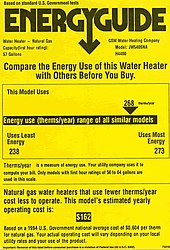EnergyGuide

TheEnergyGuideprovides consumers in the United States information about theenergy consumption,efficiency,andoperating costsof appliances andconsumer products.
Clothes washers,dishwashers,refrigerators,freezers,televisions,water heaters,windowair conditioners,mini split air conditioners, central air conditioners, furnaces,boilers,heat pumps,and other electronic appliances are all required to have EnergyGuide labels.[1]The label must show the model number, the size, key features, and display largely a graph showing the annual operating cost in range with similar models, and the estimated yearly energy cost.[2][3]
Appliance energy labeling was mandated by theEnergy Policy and Conservation Actof 1975, which directed theFederal Trade Commissionto "develop and administer a mandatory energy labeling program covering major appliances, equipment, and lighting."[4]The first appliance labeling rule was established in 1979 and all products were required to carry the label starting in 1980.
Energy Staris a similar labeling program, but requires more stringent efficiency standards for an appliance to become qualified, and is not a required program, but rather a voluntary one.
See also
[edit]- EnerGuide– A similar label used in Canada which also includes a whole-house evaluation
- European Union energy label– A similar label used in European Union
- Energy rating label– A similar label in Australia & New Zealand
References
[edit]- ^"Shopping for Home Appliances? Use the EnergyGuide Label".Federal Trade Commission.RetrievedApril 30,2013.
- ^Newsome, Hampton."FTC's Appliance Labeling Rule"(PDF).Archived fromthe original(PDF)on June 21, 2013.RetrievedApril 30,2013.
- ^"Rule Concerning Disclosures Regarding Energy Consumption and Water Use of Certain Home Appliances and other Products Required Under the Energy Policy and Conservation Act (Appliance Labeling Rule) "(PDF).Federal Register.72(167): 49948–49997. August 29, 2007. Archived fromthe original(PDF)on March 20, 2013.RetrievedApril 30,2013.
- ^Vaidyanathan, Shruti; Nadel, Steven; Amann, Jennifer; Bell, Casey J.; Chittum, Anna; Farley, Kate; Hayes, Sara; Vigen, Michelle; Young, Rachel (2013).Overcoming Market Barriers and Using Market Forces to Advance Energy Efficiency(PDF).Washington, DC: American Council for an Energy-Efficient Economy.RetrievedApril 30,2013.[permanent dead link]
